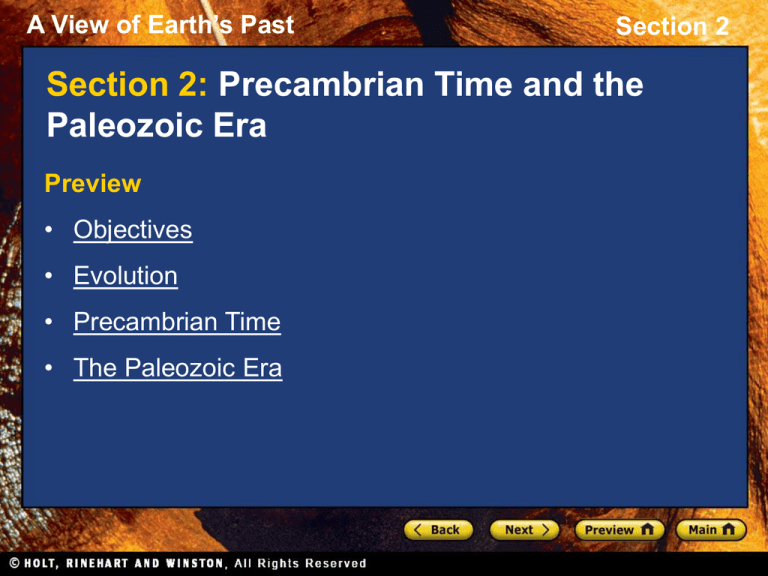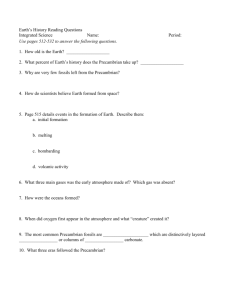Earth's Past: Precambrian & Paleozoic Era
advertisement

A View of Earth’s Past Section 2 Section 2: Precambrian Time and the Paleozoic Era Preview • Objectives • Evolution • Precambrian Time • The Paleozoic Era A View of Earth’s Past Section 2 Objectives • Summarize how evolution is related to geologic change. • Identify two characteristics of Precambrian rock. • Identify one major geologic and two major biological developments during the Paleozoic Era. A View of Earth’s Past Section 2 Evolution • evolution an inheritable change in the characteristics within a population from one generation to the next; the development of new types of organisms from preexisting types of organisms over time. • By examining rock layers and fossils, scientists have discovered evidence that species of livings things have changed over time. • Scientists call this process evolution. A View of Earth’s Past Section 2 Evolution, continued Evolution and Geologic Change • Scientists think that evolution occurs by means of natural selection. Evidence for evolution included the similarity in skeletal structures of animals. • Major geologic and climatic changes can affect the ability of some organisms to survive. • By using geologic evidence, scientists try to determine how environmental changes affected organisms in the past. A View of Earth’s Past Evolution, continued Section 2 A View of Earth’s Past Section 2 Evolution Click the button below to watch the Visual Concept. A View of Earth’s Past Section 2 Precambrian Time • Precambrian time the interval of time in the geologic time scale from Earth’s formation to the beginning of the Paleozoic era, from 4.6 billion to 542 million years ago. • The time interval that began with the formation of Earth and ended about 542 million years ago is known as Precambrian time, which makes up 88% of Earth’s history. A View of Earth’s Past Precambrian Time, continued Section 2 A View of Earth’s Past Section 2 Precambrian Time, continued • The Precambrian rock record is difficult to interpret, therefore we do not know much about what happened during that time. • Most Precambrian rocks have been so severely deformed and altered by tectonic activity that the original order of rock layers is rarely identifiable. A View of Earth’s Past Section 2 Precambrian Time, continued Precambrian Rocks • Large areas of exposed Precambrian rocks, called shields, exist on every continent. • Nearly half of the valuable mineral deposits in the world occur in the rocks of Precambrian shields. • These valuable minerals include nickel, iron, gold, and copper. A View of Earth’s Past Section 2 Precambrian Time, continued Precambrian Life • Fossils are rare in Precambrian rocks mostly because Precambrian life-forms lacked bones, or other hard parts that commonly form fossils. • One of the few Precambrian fossils that have been discovered are stromatolites. • The presence of stromatolite fossils in Precambrian rocks indicates that shallow seas covered much of Earth during that time. A View of Earth’s Past Section 2 The Paleozoic Era • Paleozoic Era the geologic era that followed Precambrian time and that lasted from 542 million to 251 million years ago. • Paleozoic rocks hold an abundant fossil record. The number of plant and animal species on Earth increased dramatically at the beginning of the Paleozoic Era. • Because of this rich fossil record, the Paleozoic Era has been divided into seven periods. A View of Earth’s Past Section 2 The Paleozoic Era, continued The Cambrian Period • The Cambrian Period is the first period of the Paleozoic Era. • Marine invertebrates thrived in the warm waters that existed during this time. • The most common of the Cambrian invertebrates were trilobites. Scientists use many trilobites as index fossils to date rocks to the Cambrian Period. A View of Earth’s Past Section 2 The Paleozoic Era, continued The Cambrian Period • The second most common animals of the Cambrian Period were the brachiopods, a group of shelled animals. • Fossils indicated that at least 15 different families of brachiopods existed during this period. • Other common Cambrian invertebrates include worms, jellyfish, snails, and sponges. A View of Earth’s Past Section 2 The Paleozoic Era, continued Reading Check Name three common invertebrates from the Cambrian Period. Your answer should include three of the following: brachiopods, trilobites, jellyfish, worms, snails, and sponges. A View of Earth’s Past Section 2 The Paleozoic Era, continued The Ordovician Period • During this period, populations of trilobites began to shrink, and clamlike brachiopods and cephalopod mollusks became the dominant invertebrate life-form. • Colonies of graptolites also flourished in the oceans, and the first vertebrates appeared. • The most primitive vertebrates were fish, which did not have jaws or teeth and were covered with thick, bony plates. A View of Earth’s Past Section 2 The Paleozoic Era, continued The Silurian Period • During the Silurian Period, echinoderms, relatives of modern sea stars, and corals became more common. • Scorpion-like sea creatures called eurypterids also existed during this period. • Near the end of this period, the earliest land plants as well as animals evolved on land. A View of Earth’s Past Section 2 The Paleozoic Era, continued The Devonian Period • The Devonian Period is called the Age of Fishes because fossils of many bony fishes were discovered in rocks of this period. • On type of fish, called a lungfish, had the ability to breathe air. Another type of fish, Rhipidistians, were air-breathing fish that had strong fins that may have allowed them to crawl onto the land for short periods of time. • Land plants, such as giant horsetails, ferns, and cone-bearing plants also began to develop during this period. A View of Earth’s Past Section 2 The Paleozoic Era, continued The Carboniferous Period • In North America, the Carbiniferous Period is divided into the Mississippian and Pennsylvanian Periods. • During this time, the climate was warm, and forests and swamps covered most of the world. • Amphibians and fish continued to flourish, and the first vertebrates that were adapted to live on land appeared. A View of Earth’s Past Section 2 The Paleozoic Era, continued The Permian Period • The Permian Period marks the end of the Paleozoic Era, because a mass extinction of a several life-forms occurred at the end of this period. • During this time, the continents had joined to form Pangaea, and as a result, the seas that covered the world retreated. • As the seas retreated, several species of marine life became extinct. But, reptiles and amphibians survived the environmental changes.








